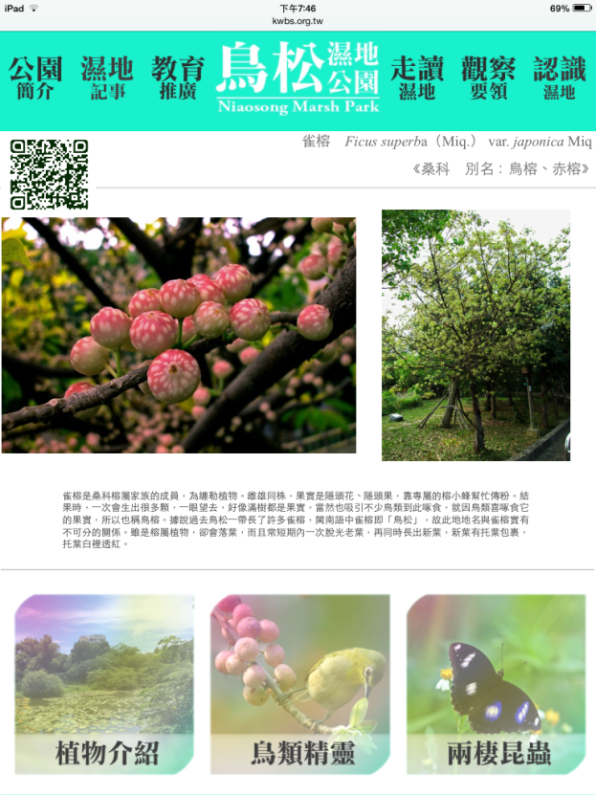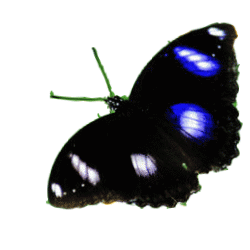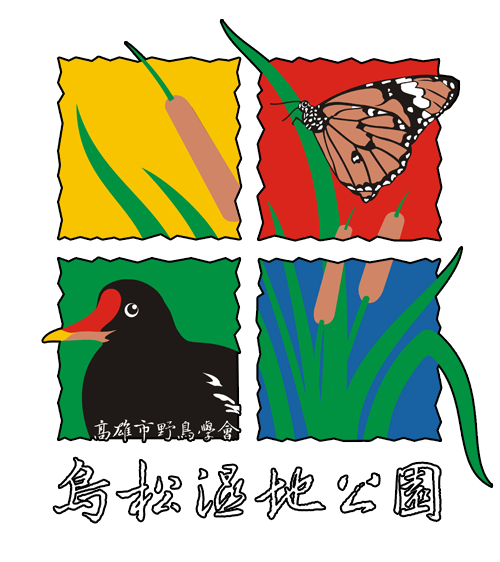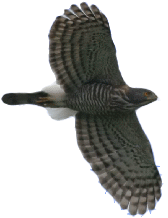| Background and Motivation of the Research | Research Methods and Procedures | Introduction of the Project |
| Analysis and Discussions | Conclusion and Suggestions |
I. Background and Motivation of the Research
When roaming on campus, there are always trees and/ or plants around us, as well as some unknown birds or insects. But wildlife cannot compare with our portable devices, cellphones and tablets. In our daily life, we always see people applying modern technology to their convenience. For example, QR-Code App is often used by newspapers and magazines to do dynamic reports of social events, and supermarkets in agricultural product traceability system. If used properly, human technology can improve quality of work efficiency and life, and conveniently and quickly save and retrieve information. Thus, what technology to use in our daily life in order to change our habits and even in our learning is an interesting issue. We students are really bored with all the tests and quizzes and a large number of theories of commerce, not sure where the studying leads to: applying the technology to the daily life or taking tests to get good grades. Not satisfied with our profession being buried, we hope to do something meaningful: an applicable and everlasting project. Under the suggestion from the instructors, we try to apply what we learn in computer science classes to manufacture an ecological touring website, incorporating the QR-Code App and handy cellphones and tablets into it, so that we can easily consult our finished website. After rounds of discussions with the instructors, we decide to apply QR-Code to immediately saving and retrieving the built-in information in our upcoming website. Finally, the team members take the unknown plants and insects on campus of in the park as the information subjects. The problem is, though we are good in designing a website, we are laymen to botany or ecology. Thus, we seek help from one of the instructors, Mr. Cheng, who is also a volunteer of Kaohsiung Wild Bird Society. He introduces us to the Society and they agree to be our partner. Until now the meaningful learning takes its form: we take Niaosong Wetland Park as the theme to participate in 2016 Cyberfair Competition.
II. Research Methods and Procedures
The team adopts the Action Research Method to complete the making of ecological touring website and QR-Code explanatory signs of Niaosong Wetland Park. During the process, we hold many discussing sessions with the instructors to revise website structure and web page contents. After reviewed by the instructors and some of our school teaching staff, the finished work is further revised. We then turn ourselves into volunteers of Niaosong Wetland Park, instructing the public to get familiar with how to use QR-Code App to consult the ecological touring website, understanding their reaction after use. Besides, we dispatch questionnaires to visitors to the Park to investigate the situation of using QR-Code App, so as to serve as the basic information of project analysis.
The project has undergone the following procedures from the very beginning of “Deciding Research Topic” to the completion of the ecological touring website of Niaosong Wetland Park”
| 1. Deciding Research Topic 2. Seeking Partners 3. Communicating and Understanding the Partners’ Needs 4. Collecting Relevant Information and Photographing 5. Manufacturing Project Website |
6. Composing QR-Code App |

III. Introduction of the Project
1. Organization Chart of Touring Website and Web page
The drafting of the ecological touring website of Niaosong Wetland Park is completed. See Chart: 3-1 for details.

Chart 3-1 The Ecological Touring Website of Niaosong Wetland Park
2. Files Tree Structure of the Touring Website
After discussing, we confirm the structure of files. See Chart 3-2 for details. We also create several file folders to classify the gathered files and pictures. Then we make buttons according to their English names, edit pictures and images, and finally construct the entire website.

Chart 3-2 Files Tree Structure of the Ecological Touring Website of Niaosong Wetland Park
3. Stereotype of the Touring Website
Referring to some stereotypes online, we decide on the form of our touring website stereotype. See Chart 3-3.
| Home Page | Items | Introduction of Animals and Plants (1 Picture) | Introduction of Animals and Plants (2 Pictures) |
 |
 |
 |
 |
| Chart 3-3: Stereotype of the Ecological Touring Website of Niaosong Wetland Park | |||
4. Completing the Ecological Touring Website of Niaosong Wetland Park
The following software apps are used to compose the website:
- For designing the website: Adobe Dreamweaver CS4 and CS6.
- For editing images: Adobe Photoshop CS4, CS6 and PhotoImpact X3.
- For word processing: Microsoft Word 2010 and 2003.
- For spreadsheet calculating: Microsoft Excel 2010 and 2003.
The original intended length of the website is less than 50 pages. But our partner adds another two parts about amphibian insects and birds to it, so that the website keeps growing. For fear that the extra pages might cause inconvenience in managing the website, we reorganize the touring website structure for several times. Applying Dreamweaver CS6 to moving and editing the web pages and updating the relevant super links cost us much time.
5. Composing QR-Code Bars
The team makes use of three QR-Code apps to compose the required QR-Code system:
- Quick Mark QR-Code.
- QR-Code scanning app of MAC i-pad mini version.
- QR-Code Auto Generator Template from Google Drive: It can create several sets of QR-Code bars. See Chart 3-4:

Chart 3-4: Google Drive QR-Code Auto Generator Template
6. Making and Arranging QR-Code Explanatory Signs
We make good use of Microsoft word 2010 and 2003, as well as Microsoft Excel 2010 and 2003, to manufacture QR-Code explanatory signs. See Chart 3-5 for making and arranging process.
 |
Chart 3-5: QR-Code Setting up Directory of Niaosong Wetland Park |
7. Evaluating Effectiveness and Revising the Website
Accepting suggestions from the instructors and concerned teaching staff at school, we make a preliminary revision of the website. Then after being assessed and reviewed by bird watching pals and volunteers from both Kaohsiung Wild Bird Society and Niaosong Wetland Park, the website is further revised. Cooperating with the Society, we produce a feedback questionnaire for bird watching pals and volunteers, asking them to give us feedbacks on how to improve the website.
The team members act as volunteers of Niaosong Wetland Park to teach the public how to use and consult the Ecological Touring Wetland (See Charts 1-1 and 1-2). After having an understanding on their after-use reaction of using the website, we dispatch questionnaires to investigate the present situation of their using it. The following are results of questionnaire analysis:
1. The Ecological Touring Website of Niaosong Wetland Park: http://www.kwbs.org.tw/wetland/
| 導覽網站首頁(圖1-1) | QR-Code查詢植物-雀榕(圖1-2) |
 |
 |
2. Questionnaire Analysis
We turn ourselves into information volunteers for doing the project, introducing the finished Niaosong Wetland Park explanatory signs to the public. During the process we discover that many visitors don’t know how to use the built-in QR-Code app in their mobile devices and that certain gaps exist in their experience in using it. To solve the problem, our team draws up a sheet of questionnaire of QR-Code use in Niaosong Wetland Park to investigate the gapping situation of the public’s using QR-Code information. First, information volunteers from our team interview the comers to know their experience of using QR-Code and, if necessary, they use Niaosong Wetland Park guided touring website as an example to do one-on-one or even two-on-one instruction, explaining how to use the guided touring app to the public. By so doing, we not only teach the public but also carry out the questionnaire survey. Totally, we dispatch 300 copies of questionnaire, all of which are collected, with 9 invalid questionnaires and the other 291 valid, reaching a high response rate of 97%. Since we rigorously implement the questionnaire survey, its reliability and validity are quite good. The following are analysis results of each questionnaire item:
| 1) Analysis of male-female ratio: | |
| From the chart on the right we know that the number (53%) of female coming to the Park is slightly higher than that (47%) of the male, with minor edge. |
|
| 2) Geopolitics analysis | |
 |
The analysis from the chart on the left shows that among Kaohsiung citizens, people living in Sanming District has the highest percentage of coming to the Park, nearly 20%, followed by residents from Fengshan District and Niaosong District, 12% respectively, still followed by those from Lingya District and Qianzhen District, 10% respectively. Visitors from out of the Great Kaohsiung account for 13%. The above figures show that residents in the neighboring districts come to visit Niaosong Wetland Park most often, with the exception of people living in Renwu District, which is located on the north of the Park. |
| 3) Age group Analysis: | |
From the right chart we can see that two age groups, from 16 to 25 years old and over 56 years old, have the highest percentage of visiting Niaosong Wetland Park, 25% respectively, followed by the age group of 46-55’s 23%. 63% of the questionnaire respondents are over 35 years old, while 37% are below 35 years old. Three age groups have the lowest percentage of answering the questionnaire: 26-35, 36-45, and teenagers below 15 years of age, which might be because we do the questionnaire interviews during the weekdays and teenagers are accompanied by their parents. This also shows that most visitors to the Park are middle-aged and senior citizens. Student visitors are mostly from high school and college students. According to our observations, Teenagers and children usually come to the Park with their parents on holidays. |
 |
| 4) Occupation analysis: | |
 |
From the left chart we know that students visit the Park most often, with a percentage of 26%, followed by retirees’ 21%, The third to the fifth are service industry workers’ 17%, homemakers’14%, and military and government employees’ 8%. The lowest percentage goes to freelancers, manufacturing worker, and financial Industry workers. All this tells us that since students, retirees, service industry workers, and homemakers come to the Park most often, the Park authority can hold exclusive activities for them to get close to nature. |
| 5) Analysis of Using QR-Code : | |
| The right chart shows percentages of visitors using QR-Code. 113 people know of QR-Code app and have the experience of using it, accounting for 39%, which means merely about 40% of the public understand that QR-Code is a familiar and convenient tool. Besides, they have used it and know its function. And 21% of the public have an understanding of QR-Code app function but never use it. Thus, 60% of the Park visitors comprehend QR-Code app function, leaving the other 40%, 117 of the questionnaire respondents, knowing nothing about QR-Code or/ and its function. Surprisingly, in this information explosion era, there should be so many people who know nothing about QR-Code’s use and function! What’s worse, among those who have used QR-Code and set up QR-Code app make up only 28%, displaying that less than 30% of the public might apply QR-Code to their mobile learning or information inquiry. |  |
| 6) Analysis of knowing of QR-Code guided touring services: | |
 |
From the previous question, we continue to analyze the public’s exact understanding on Niaosong Wetland Park’s offering QR-Code guided touring service. The left chart shows that 128 visitors, 44%, know of the service, but only 37 of them, 13%, have used it, which means the other 91, 31%, know of it but never use it. 163 visitors, 56%, know nothing about the QR-Code service. From the above analysis, we come to a total of 254 visitors, which is 87%, never using the service. Obviously, the Park management should offer hold educational sessions on how to use QR-Code guided touring service function at the initial stage of completing ecological touring website of Niaosong Wetland Park.. |
| 7) Analysis of the clarity of QR-Code signs from people having used them: | |
| According to the result from question item 6, we analyze the 37 visitors who have used QR-Code app service. 86% of them think that the QR-Code explanatory signs are clear enough, while the other 14% find it not clear enough. It means most people having used QR-Code service consider its explanatory signs to be clear and accessible; however, there are still a few of them hold the opinion that the setting positions are not conspicuous enough, that there are insufficient signs, that the signs are too far away from the sidewalks, and that usage of QR-Code guided touring service should be added. |  |
| 8) Analysis of whether QR-Code signs are clear enough to make people better understand the Park: | |
 |
Among the 37 questionnaire respondents from the previous question item, 100% of them believe that QR-Code service is good enough to make people get a whole picture of Niaosong Wetland Park, meaning all users of QR-Code service maintain that QR-Code ecological guided touring service developed mostly by our team is sure to make people coming to the Park better understand it. |
| 9) Analysis of having known of but never using QR-Code guided touring: | |
| According to the questionnaire survey, 31% of the public know of QR-Code ecological touring service but never use it. Thus, by analyzing their causes for not using it, we discover that without the needs to consult the service accounts for 72%, that with no network for them to refer to QR-Code guided touring information takes up 23%, and that some of the public don’t have their own cellphones, or they just don’t take the trouble or their networks are not powerful enough for QR-Code service. |  |
| 10) Analysis of whether QR-Code guided touring services from information volunteers are clear enough to make visitors understand: | |
 |
After analyzing the 254 respondents, 87%, of all who receive the questionnaire survey and having never used QR-Code guided touring service, we get the result that the QR-Code touring guides and audio commentaries from information volunteers definitely make them better understand the guided touring service. 97% of them understand much more than they did previously, with only 3% learning nothing more. This means the information volunteers’ hard work pays off greatly. Thus, our suggestion is that more information volunteers be assigned to do such service. |
| 11) Analysis of whether people who are familiar with QR-Code services will keep using them to check out information they need: | |
| Continuing the previous analysis, we find that 59% of the respondents, after the information volunteers’ guided touring service, will continue using QR-Code service to consult what they want, while 15% of them will cease using it because of no Internet service, and still 13% won’t take the trouble to use it. From the above figures we know that most Park visitors find QR-Code developed by our team helpful. Hopefully, in the near future Niaosong Wetland Park can set up public i-Taiwan wireless network, so that people without the Internet service at home or those who with insufficient bandwidth can also experience the convenience of mobile learning. |  |
| 12) Analysis of overall evaluation of QR-Code guided touring services from the public: | |
 |
The left chart shows that the 13% of the visitors having used QR-Code guided touring service fully regard it as a QR-Code service which can equip the public with a better understanding about Niaosong Wetland Park. And among the 87% of the visitors who have never used QR-Code service, after the guided touring service and audio commentaries from the information volunteers, all but 3% of whom have a better understanding of the service. Besides, nearly 60% of the visitors will keep using the service to do information inquiry. At last, we analyze the overall assessment of QR-Code guided touring service from the visitors. 37% of them are very satisfied, 46% are satisfied, and 16% think it so-so. Only 1% of the respondents find it unsatisfactory. Adding up the numbers, we reach an 83% satisfaction with QR-Code guided touring service. Even with such a high satisfaction level, we still have 17% room for improvement, which will be our team’s future exertion. |
The completed Ecological Touring Website and QR-Code explanatory services created collaboratively by our team and Kaohsiung Wild Bird Society, a professional ecological team, gain recognition from the public. The following are results from the questionnaires:
- The accomplishment of our Ecological Touring Website of Niaosong Wetland Park is highly complimented by the teaching staff, volunteers from both Kaohsiung Wild Bird Society and Niaosong Wetland Park. They agree that the website structure is clear and concise and user-friendly. Besides, the QR-Code system is also easy to master.
- Though professional and clear, the Ecological Touring Website text commentary of some items is too sketchy. The way to improve it is to enrich them with relevant information, so that users can understand more about the species they are interested.
- Using QR-Code app to save and retrieve species information from the Ecological Touring Website is convenient and practical. If voice touring function is added or it can be connected to concerning videos, the website will be richer in content, so that the public can have a better understanding of species ecology.
- The website and its files structure should be flexible so that they can be revised and expanded. Though a strict planning has been reached before the website’s being set up, some additions in the future is not impossible. Thus, our suggestion is that for the convenience of future management, reorganization of the website and its files structure should be possible.
- File names should be in English and avoid using blank space; otherwise, these blanks might cause problems in connecting to the QR-Code app.
- During the process of assembling and manufacturing files for QR-Code explanatory signs, people in charge should meticulously match QR-Code bars with those of the species names, and then test the connection.
- Seeking a professional partner to cooperate and holding discussing sessions beforehand is very important, so that when problems occur, a best solution can be reached. We are lucky enough to have Kaohsiung Wild Bird Society, which is a professional group, as our partner.
- QR-Code app should be intact and operable. If damaged, the QR-Code bars cannot be read correctly.
- PBL learning is not only a way to check the learning achievement, but also an opportunity to cooperate with some NGO group, collaboratively searching a topic meaningful to the society, so as to do a little social responsibility of a citizen. Through our cooperation with Kaohsiung Wild Bird Society, we have a better understanding on the real situation of their volunteers maintaining wildlife’s habitats.
- Partner’s cooperation makes the project complete and better, so their opinions should be respected; otherwise, interference from each other might occur.
- From the questionnaire analysis, we know that sex difference on people coming to the Park is minor, and most of them come from neighboring districts, such as Sanming, Fengshan, and Niaosong Districts. And among the visitors to the Park, middle- and old-aged citizens over 35 years old and students about 16 to 25 years old (This poses a little problem because we dispatch the questionnaire copies in winter vacation.) account for the majority, followed by service industry workers and homemakers.
- After the investigation we have found that nearly 40% of the questionnaire respondents have used QR-Code, and only 28% of them have installed the app, showing that in this era of quick information flow, unfortunately, most people still don’t use QR-Code to do information inquiry. Among those who have used it, 100% of them find that the QR-Code app developed by our team is definitely helpful for the public to have further understanding of wetlands.
- The team also discovers that 60% of the public don’t know of the QR-Code guided touring service, which means that after the installation, the QR-Code service needs to be reinforced. After the commentary service from the information volunteers, up to 97 % of the public have a better understanding of the service, and near 60 % indicate that they will keep using the service to do the information inquiry.
- If there is public Wi-Fi in the Park area, 75% of the public are much more willingly to use the QR-Code service. Hopefully, in the not-to-far future, Niaosong Wetland Park is able to set up the public Wi-Fi, giving the public the convenience of experiencing mobile learning. Though there is still room for improvement, the team is grateful that 85% of the public are satisfied with the QR-Code service mainly developed by us.
- Doing PBL project is really helpful in understanding the future real workplace situation. We also realized the importance of integrating school learning, daily life context, and social application into the project.





















